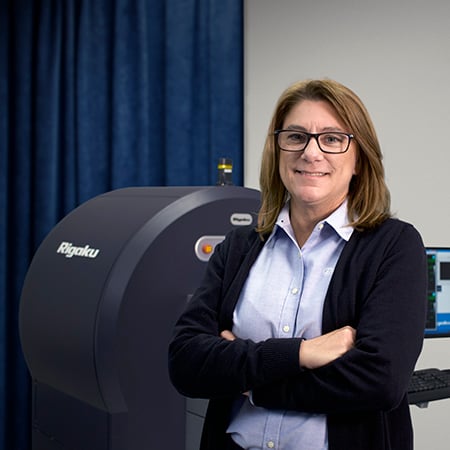In functional failure analysis, we often look at minor changes within materials or components that affect performance. For example, a pool filter can clog over time, reducing efficiency. By understanding these kinds of failures, manufacturers can improve designs, boost product performance, and keep customers happy.
How X-ray CT supports functional failure analysis
X-ray computed tomography (CT) enables us to examine the insides of objects in detail without taking them apart. CT is an essential tool for functional failure analysis because the non-destructive nature of this analytical technique allows for failure analysis before an object reaches complete breakdown. CT provides high-quality 3D images, showing us internal defects like voids and inclusions in batteries or wire breaks and shorts in electronic devices. Recent advancements have made X-ray CT even more powerful, allowing us to convert massive amounts of volume data into insightful information, such as void distribution and 3D models for simulations.
Different levels of CT analysis
You can analyze various aspects of your sample using CT, including porosity, wire connectivity, volume continuity, filter efficiency, etc.
- Sometimes, 3D data inspection is enough.
- Quantitative analysis may require segmentation.
- Simulation can be powerful in optimizing designs and life cycles.
In contrast, if we want to estimate the lifetime of filter materials based on the digital model created using CT data, segmenting the data, creating a fiber model, and running a simulation is required. The example below shows the result of such a simulation where the total dust-holding capacity and pressure drop can be calculated by running a filter lifetime simulation using X-ray CT data of filter media and GeoDict (include link to software) software.

How to choose the right CT scanner
The process starts with choosing the right CT scanner and its settings based on the object’s size and material. Large or dense objects need higher energy levels, while small components benefit from high-resolution imaging.
To learn more about how to choose the right CT scanner and analysis tools, these blog articles might help:
- How to Choose kV and Filter for Your Micro-CT Experiment
- How to Improve the Resolution of X-ray CT Images
- How to Improve the Signal-to-noise Ratio of X-ray CT Images
After scanning, the data is transformed into a 3D model for detailed inspection. For complex cases, AI-powered segmentation tools help separate different materials and zero in on specific issues, such as finding a small spot for leakage, simulating the efficiency of filter materials, or investigating the cause of diminished battery capacity.
Real-world examples of functional failure analysis
X-ray CT has a range of applications across industries. In automotive manufacturing, CT scans can identify leaks or structural issues in cooling systems. In electronics, it’s used to check solder joints and circuit boards. For batteries, CT can reveal problems in electrode overhand and layering, which affects lifespan. These insights help improve product designs, whether it’s for cars, phones, or energy storage.
In the example shown below, the spot causing a leak in a microchannel heat exchanger (MCHE) was identified by a CT scan and segmentation of aluminum and air. The segmented air, or a hole in this case, was further quantified to evaluate the size of the leak spot.

In this example, a Li-ion battery whose function deteriorated significantly was investigated using a CT scan. A large amount of deformation and voids were observed, and the thickness of the voids was quantified after segmentation.

Tackling challenges in CT data analysis
Segmenting CT data accurately can be tough, especially with complex materials. The recent advancement of artificial intelligence and machine learning data processing tools has made even the most challenging segmentation task possible and more precise, allowing us to analyze internal structures more easily. This means the CT technique has advanced and become more accessible, and manufacturers can detect and address potential issues more effectively, ultimately leading to preventing complete failure of their products as well as higher product quality.
Taking failure analysis to the next level with simulations
Simulations allow us to predict how products will handle stress, flow, or heat. For example, simulating particle flow in a filter helps design filters that last longer. For batteries, simulations can predict lithium movement, helping researchers develop longer-lasting products. Together with CT scans, simulations make it easier to identify potential problems early and speed up the design process.
You can see more examples and instructions on filter and battery simulation analyses in these webinars:
- Deep Dive Webinar Series – Filtration
- Math2Market – GeoDict – Digital Development of Materials for Filtration
- Beneath The Surface: X-ray Analyses of Battery Materials and Structures Non-Destructive Inspection of Batteries Using X-ray Computed Tomography
In short, X-ray CT combined with simulations offers powerful tools for understanding product failures and enhancing design. With these techniques, manufacturers can create products that are more reliable, efficient, and durable, meeting and even exceeding consumer expectations.
What's next
As artificial intelligence and machine learning analysis tools improve further, more complex analyses will be more accessible to non-experts. X-ray CT will play an increasingly crucial role in functional failure analysis to prevent failures, improve product reliability, and even speed up the materials development process.
To learn more about functional failure analysis and see more example investigations using CT, check out the additional resources and watch the original webinar recording here: Decoding Defects: Failure Analysis Using X-ray CT - Functional Failure Analysis.
I hope this article helped you see how helpful CT can be in functional failure analysis. If you are not sure which type of CT scanner is suitable for your failure analysis needs, our team of CT experts can help you figure out the best fit. You can talk to one of our CT experts by clicking the “Talk to an expert” button at the top right of the page or sending us a message at info@rigaku.com.




